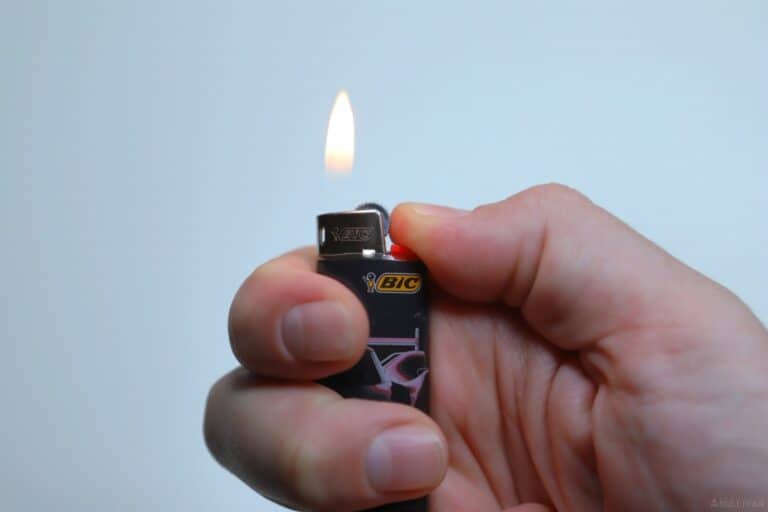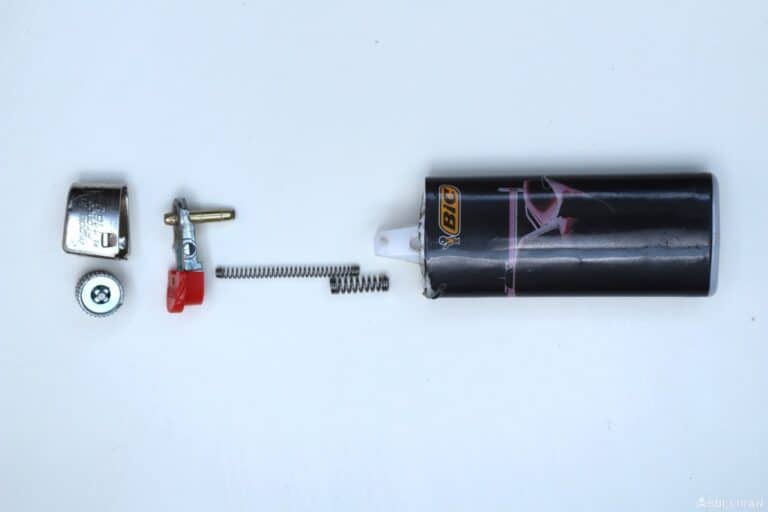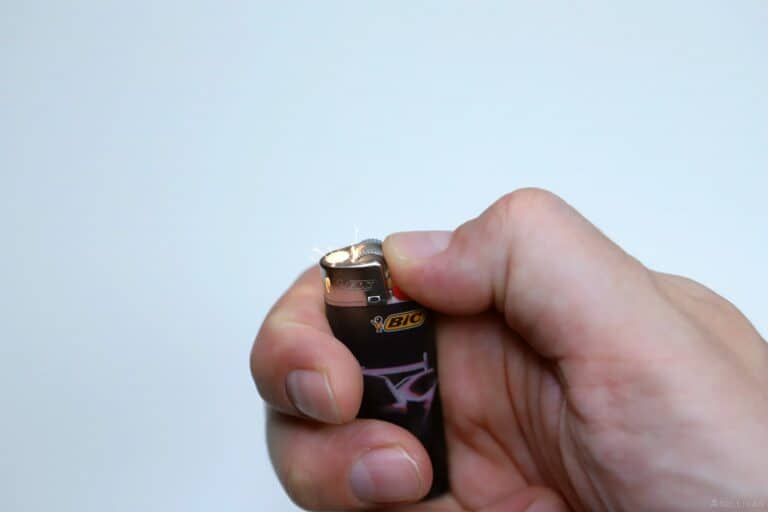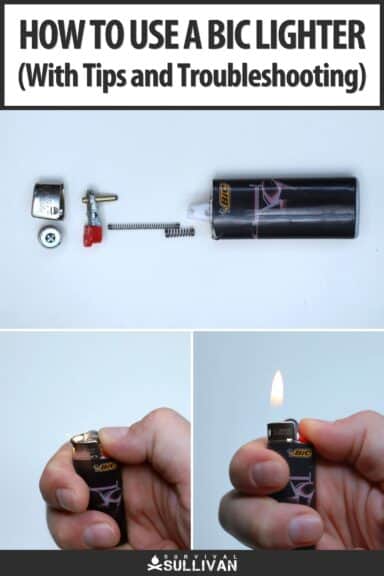Lighters are tools that are so easy to take for granted. Fire has ever been critical to mankind’s survival, and without a lighter you’ll have to work really, really hard to build one. With a lighter, you can summon it with literally a snap of your fingers.

And when it comes to lighters, there are none more recognizable or more common than the humble Bics.
Bic has produced countless dirt-cheap, disposable and most importantly reliable lighters since they got started back in 1973, and they are an invaluable tool in everyday use and in survival situations.
I’ll tell you everything you need to know about how to use one and how to keep it working below.
What is a Bic Lighter, Exactly?
A Bic lighter is a butane fueled, disposable pocket lighter.
Bic denotes both the brand and the manufacturer, Société Bic, and also refers to the inventor of the lighter and co-founder of the company, Marcel Bich.
Despite being one of the most popular and also cheapest disposable lighters around, there are countless imitators available domestically and abroad, and the generic term Bic sometimes refers to any such disposable butane lighter.

What are the Components of a Bic Lighter?
Bic lighters are a picture of simplicity, consisting of a plastic casing or body which has:
- a fuel reservoir full of butane,
- an internal pipette which delivers fuel to the igniter assembly,
- a button or trigger which releases fuel from the reservoir,
- a sparker wheel which creates a spark to ignite the stream of released fuel,
- and a flint which actually produces the sparks when the sparker is rotated.
The chimney is the metal apparatus which holds the sparker and provides a measure of safety for the user when the flame is created.
Not much to it, but despite how simple these lighters are, they’re highly reliable and very effective.
How to Use a Bic Lighter, Step by Step
Chances are you already know how to use a Bic lighter, but if you don’t it is time to learn! Don’t be embarrassed, everyone started somewhere.
Step 1: Hold the lighter with the button facing towards you and the chimney pointing up. This will set you up for success and easy activation, and is also the safest way to hold a Bic.
Step 2: Place your thumb on top of the sparker wheel.
Everyone does this a little bit differently. Some people like to use just the tip of their thumb, others like to use the pad, and some choke all the way up to the last joint.
What is important is that you can apply pressure to the sparker wheel and move your thumb down onto the button in one swift, sure movement.
Step 3: Press thumb to rotate sparker and depress button. This is the trickiest part of learning to use any disposable lighter.
You need to briskly rotate the sparker downward and make sure your thumb comes to rest on the button, and do this in one quick, sharp move.
This will ensure that the sparker produces a shower of sparks which will subsequently ignite the stream of fuel released by the button. Practice the movement a few times until you get it right.

Step 4: Keep button depressed to ignite flame. Assuming that your lighter is functional and has fuel, if you did the previous step correctly, you should have a nice flame coming out of your lighter.
Use this to light your cigarette, candles, tinder, or anything else that needs to be set on fire!
Step 5: Release button to extinguish flame. Assuming your Bic is working properly, the instant you release the button to cut off the flow of butane, the flame should go out.
Note that you generally don’t want to leave a Bic ignited for any longer than 30 seconds at a time because the metal chimney can get very hot and, potentially, melt the plastic casing.
Step 6: Allow lighter to cool. For anything but the quickest lights, make sure you let the metal of the chimney cool down before you put your Bic back in your pocket or put it away.
You don’t want to burn yourself or start any accidental fires, now do you?!
And that’s it! You have now passed the bar to become a certified Bic lighter user. All jokes aside, it really is that simple, there’s nothing to it…
How Can You Make the Flame Larger?
Bic lighter flames are not adjustable, not externally.
It is possible to take off the metallic outer part of the chimney and tinker with the internals to force your Bic lighter to produce a larger flame, but they aren’t designed to.
How Many Lights is a Bic Lighter Good For?
According to the manufacturer, a Bic lighter is good for around 3,000 lights.
Practically speaking, the amount of lights you get out of your Bic is going to be determined by how long you keep the button depressed when ignited.
Longer lights mean you will have less lights overall, while shorter lights means you have more lights overall.
It’s worth pointing out that your Bic will, almost invariably, use up its fuel supply before the flint is worn down or another part breaks, rendering it useless.
What Kind of Fuel Does a Bic Lighter Use?
Bic lighters are butane fueled. Butane is extremely flammable, colorless, and is a vapor at room temperature.
It is a type of liquid petroleum, or LP, gas similar to propane, propylene and isobutylene.
It’s also worth mentioning that when butane is burned in the presence of plentiful oxygen, the only combustion by-products are carbon dioxide and water vapor, meaning butane is a low-polluting fuel in most circumstances.
However, when burned in a limited oxygen environment, carbon monoxide may also be produced along with carbon.
Something else to know is that most varieties of butane are mixed with an odorific element that smells distinctly bad, enabling you to detect it if there is a fuel leak.
Are Bic Lighters Refillable?
No. Bic lighters are disposable, and not refillable by the user.
As part of the filling process at the factory, the fuel reservoir is filled with butane and sealed shut in basically one process.
When your Bic is out of fuel, that’s it. You’ll have to throw it away and grab another one.
However, some crafty users and diehard conservationists have figured out a way to refill a Bic lighter with fuel yourself, either by drilling a hole in the bottom or dismantling the upper assembly and fueling it from the top.
It should be noted that both of these procedures are fiddly and fairly dangerous, so it’s probably not worth the time or money to try.
If you want a refillable butane lighter, there are other brands that can be refilled with common butane fuel canisters. Or you could go with a classic, multi-fuel lighter like a Zippo!
Not all Disposable Lighters are Bics!
It is worth mentioning again: as I said above, not all disposable lighters are Bics, even though they are all invariably called that in common conversation.
This means you might come across a butane lighter that looks very much like a classic Bic, but it has features like an adjustable flame, a refueling port, or even a completely different ignition system such as a piezoelectric or “clicky” button, sans spark wheel.
You can use these lighters very much the same as I outlined above, but bear in mind that they might have different features!
Tips and Troubleshooting
As good and reliable as Bic lighters are, they aren’t perfect. If you’re having trouble with your Bic, read the following to figure out some tips and get some troubleshooting.
Sparks but No Flame? Might be Out of Fuel
If you’re trying and trying but your Bic just won’t produce a flame, it might be low or out of fuel.
Time to do a status check: observe and see if the sparker is producing any sparks. If it isn’t, even if your lighter still has fuel, you’re not going to ignite it to produce a flame.
If it is producing sparks, depress the button and listen closely to see if you can hear the hiss of escaping fuel.
If that doesn’t work, shake the lighter near your ear and you might be able to hear a liquid fuel sloshing inside.
If both of those are a negative, your Bic is probably just out of fuel. Ditch it.
The Wheel Turns but Isn’t Making Sparks
If you’re sure your lighter has fuel and the wheel is turning but isn’t producing any sparks, listen closely for that scratchy sound of the wheel rubbing against the flint.
If you hear that scratching sound, you might have a drop of water or other moisture accumulation inside the assembly of the lighter which is preventing the sparks.
Give the lighter some time to dry out and then try again.
The Wheel Won’t Spin
If the wheel of your lighter just won’t turn, or only turns with considerable effort, the assembly might be damaged or jammed by debris.
If it won’t turn at all, it is likely that your flint, somehow, has worn away to nothing and the wheel is catching on the post which supports it.
If this is the case, your very best bet is to just get a new lighter.
They aren’t designed to be user-serviceable, and they are so cheap it frankly isn’t worth your time to try and repair them.
It’s Too Hard to Spin the Wheel
You aren’t the first to struggle with that.
If you don’t mind making your Bic slightly less safe, you can grab a pair of needle nose pliers or small, hobby-sized side cutters and pry off the thin, metal band that runs down the middle of the wheel.
This is the “child safe” device that the US government mandates all such lighters have.
Removing this band means you can turn the wheel with less downward pressure from your thumb, simplifying activation.

The post How To Use a Bic Lighter (with Tips and Troubleshooting) appeared first on Survival Sullivan.
By: Tom Marlowe
Title: How To Use a Bic Lighter (with Tips and Troubleshooting)
Sourced From: www.survivalsullivan.com/how-to-use-a-bic-lighter/
Published Date: Thu, 12 Oct 2023 23:00:00 +0000
------------------------
Did you miss our previous article...
https://bushcrafttips.com/bushcraft-news/what-is-comsec-and-what-does-it-stand-for
 What is BushcraftSurvival SkillsToolsVideosBushcraft CampsBushcraft KitsBushcraft ProjectsPrivacy PolicyTerms And Conditions
What is BushcraftSurvival SkillsToolsVideosBushcraft CampsBushcraft KitsBushcraft ProjectsPrivacy PolicyTerms And Conditions
